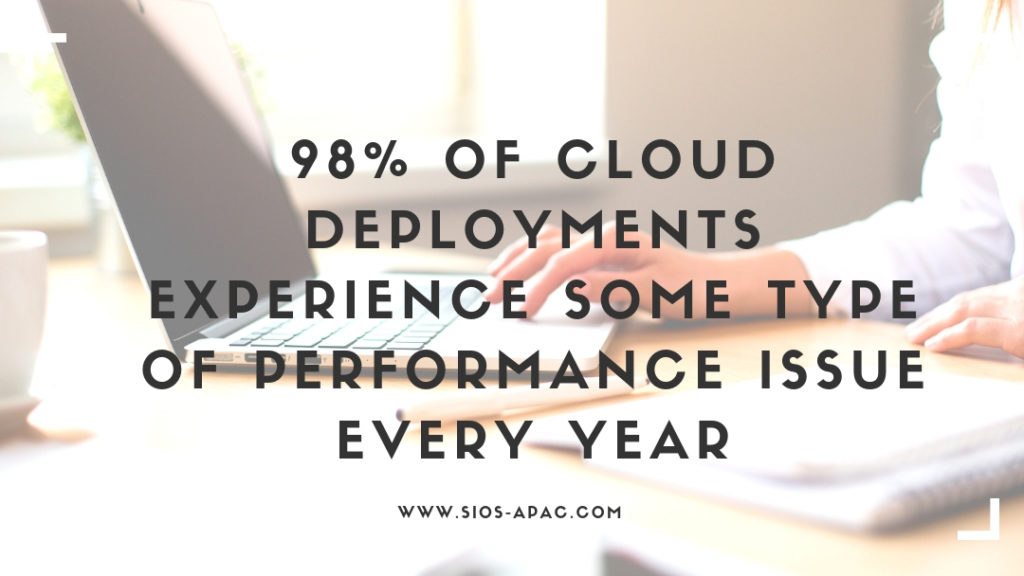Date: January 20, 2019
Tags: High Availability
Survey On State Of Performance And High Availability For Mission-Critical Applications In SME
According to a new survey by SIOS Technology, in partnership with ActualTech Media Research, a full 98% of cloud deployments experience some type of performance issue every year.
The survey was designed to understand current challenges and trends related to the state of performance and high availability for mission-critical applications in small, medium and large companies. A total of 390 IT professionals and decision-makers responded, collectively representing a cross-section those responsible for managing databases, infrastructure, architecture, cloud services and software development. Tier-1 applications explicitly identified include Oracle, Microsoft SQL Server and SAP/HANA.
There are some clear trends. A few surprises that we didn’t see coming, and that might surprise you as well.
■ Small companies are leading the way to the public cloud with 54% planning to move more than half their mission-critical applications there by the end of 2018, which compares to 42% of large companies
■ For companies of all sizes, having complete control over the application environment was cited by 60% of the respondents as a key reason for why their mission-critical workloads remain on premises
■ Most (86%) organizations are using some form of failover clustering or other high availability mechanism for their mission-critical applications
■ Almost as many (95%) report having experienced a failure in their failover provisions
It’s evident that organizations are finally moving their critical applications to the cloud. And at a greater pace than we could have imagined a few years ago. But they’re still in the early days of adoption, placing mature operations a few years away. Here are some more details.
Misery Loves Company
A mere 2% of respondents claimed they never experience any application performance issues that ever affect any end users. The rest of us mere mortals claim to experience such issues. Here are the stats on average.
- Daily (18%)
- 2-3 times per week (17%)
- Once per week (10%)
- 2-3 times per month (15%)
- Once per month (11%)
- 3-5 times per year (18%)
- Only once per year (8%)
The responses were reasonably consistent among Decision Makers, IT Staff, and Data & Development Staff with one notable exception: Decision Makers perceive a lower occurrence of performance issues than staff does. Nearly half (46%) of Decision Makers responded that performance issues occur 3-5 times per year or less (compared to 23-25% for staff). Only 11% responded that issues occur daily (compared to 20-21% for staff).
Rapid Response to the Rescue
One possible explanation for this apparent discrepancy is IT Staff being made aware of problems affecting performance with an automated alert. This is followed by a rapid response to find and fix the cause.
The survey asked about high availability provisions failing (something that is certain to affect performance!). 77% learn of the problem via an alert from monitoring tools. Another 39% learn from a user complaint. (Note that multiple responses were permitted.)
As for remediation, it takes more than 5 hours to fix a problem only 3% of the time. Nearly a quarter (23%) are fixed in less than an hour and over half (56%) are fixed in 1-3 hours. Finally, 18% are fixed in 3-5 hours. Small companies are able to resolve problems more quickly (31% in less than an hour) than large ones (only 11% in less than an hour). This likely because the former utilizes the public cloud more extensively and has less complex configurations.
Culprits In The Cloud
When asked about the cause of performance issues that arise in the cloud, the main culprits are the application or the database being used. Together they account for 64% of the issues. It is important to note that this question did not distinguish between who is responsible for the managing the application and/or database, which would likely be the cloud service provider for a managed service. Additional causes include issues with the service provider (17%) or the infrastructure (15%). In 4% of the cases, the issue remained a mystery.
